March 2015
MATH TOOLS
Let’s start off with some tools that you can use in multiple ways to develop math concepts.
HIGHWAY NUMBER VESTS
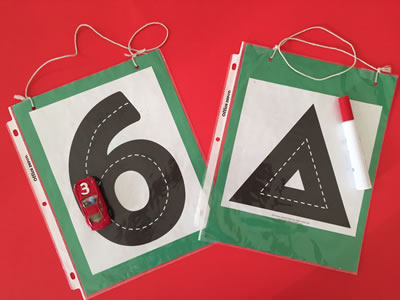
Highway shapes and numbers can be downloaded free at makinglearningfun.com. Place these in clear sheet protectors, punch holes at the top, and tie on strings so they can be worn around the neck.
•Make your own math signs (+ - = < >) to use with these activities.
Writing Numerals – Children can trace over numerals with toy cars or they can roll play dough and place it on top of the numerals. They can also trace over numerals with a dry erase marker and erase.
Counting – Have children get in numerical order according to the number they are wearing.
Songs – Wear number vests as you sing “Five Little Monkeys,” “I Know An Old Lady Who Swallowed a One,” and other songs.
Inequalities - Put up two numbers and have children choose “<” or “>” to go between them.
Addition and Subtraction – Have children make number sentences using the numbers and signs on the vests.
Fact Families – Move numbers around to demonstrate different fact families.
Decomposing Numbers – Call out a number. Children find a friend to equal that amount.
Tens and Ones – Let children demonstrate tens and ones with vests.
Word Problems – Use number vests to engage children in solving word problems.
Dot to Dot - Pass out numbers and have children scatter around the
room. Give one child a large pointer. That child takes the pointer and
goes from “0” through “10” by “connecting the dots.”
Highway Shapes – Do similar activities by putting highway shapes in clear sheet protectors.
DOING DOT CARDS
•Dot cards can be downloaded free from several sites on the internet.
Try this search: DotCardSearch - DrJean
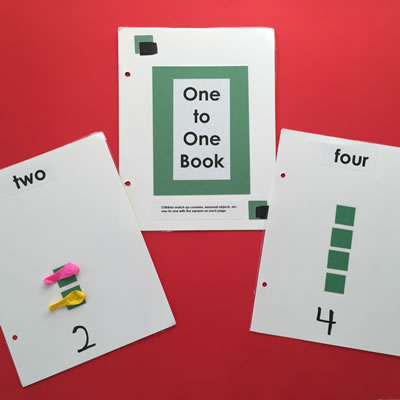
One to One
Children match up pompoms, beans, erasers, pebbles, and other small objects with dots on cards.
Dot Flash
The teacher quickly holds up a dot card and then places it face down. The children hold up that number of fingers on their chest. Ask, “How did you know it was that number?”
Clip It
Children use the appropriate number of paper clips or clothespins to attach to the dot cards.
Copy Cat
The teacher holds up a dot card. The children try to reproduce the pattern with their own counters.
Sorting
Sort dot cards by amount. Sort odd and even cards.
Line Up
Students line up the dot cards in numerical order from largest to smallest or smallest to largest.
Matching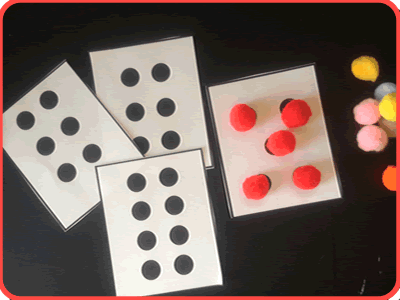
Match dot cards with dots on dice.
Match dot cards with ten frames with the same amount.
Make puzzle games where children match dots with numerals or words.
Partner Count
Cards are placed face down on the table. One card is turned over and the first child to say the number gets to keep the card. The partner must count the dots to verify it’s correct.
•To make the game more challenging, ask them to say one more than the quantity of dots, one less, two more, etc.
Memory
Run off two sets of dot cards. Place them face down on the floor. One child at a time turns over two cards. If the cards match they make keep them and take another turn. If the cards don’t match, they are turned back over and the next child takes a turn.
Top It
You will need several sets of dot cards for this game. Shuffle the cards and lay them face down in a pile. One child at a time chooses a card. The child with the largest number of dots wins both cards. If they turn over the same amount they continue to draw cards until one player has a higher number.
It Adds Up
Two children have a set of cards and face each other. They each turn over a card and add up the amount. The first child to correctly say the answer gets to keep the cards.
TEN FRAME
•Five, ten, and twenty frames are available to download on the internet. Try this link:
Five_ten_twenty_frames - Dr. Jean
Building Sets
Call out a number and demonstrate how to place the counters in the frame starting on the left. Remind them to always start with the first frame on the left.
•Turn the frame vertically to make sets.
•Can you place the counters in a different way?
•Have children count forwards and backwards on their frames.
Rock and Roll
Children take one or two dice, roll them, and build that amount on their frame.
Flash
Show a numeral or dot card. Challenge children to make the set on their frame.
Add and Remove
Have students fill up their frame with counters. Call out a number. Can they remove counters or add counters to build the new number?
Addition and Subtraction
Place counters for the first addend on the top row and the second addend in the bottom row. How many altogether?
•Take away counters for subtraction problems.
Double Frames
Extend to a double ten frame for building numbers to 20.
Giant Ten Frame
Draw a large ten frame on the sidewalk with chalk. Let children stand in the frames to make sets, add, subtract, etc.
•Make a giant ten frame on the floor in your classroom with tape or use a shower curtain liner to make a giant frame.
REKENREK
Rekenrek comes from the Netherlands and is basically  an arithmetic (or calculating) rack. It’s a visual way for children to develop a strong sense of 5 and 10. Children can use the rekenrek to count, add, or decompose numbers. Smaller versions of the rekenrek have two rows of ten beads. Five red beads and five white beads. (Versions for older students have more rows.) You can purchase these or make your own from fun foam or cardboard, pipe cleaners, and pony tail beads. String 10 beads (5 of each color) on the pipe cleaner and attach it to the fun foam.
an arithmetic (or calculating) rack. It’s a visual way for children to develop a strong sense of 5 and 10. Children can use the rekenrek to count, add, or decompose numbers. Smaller versions of the rekenrek have two rows of ten beads. Five red beads and five white beads. (Versions for older students have more rows.) You can purchase these or make your own from fun foam or cardboard, pipe cleaners, and pony tail beads. String 10 beads (5 of each color) on the pipe cleaner and attach it to the fun foam.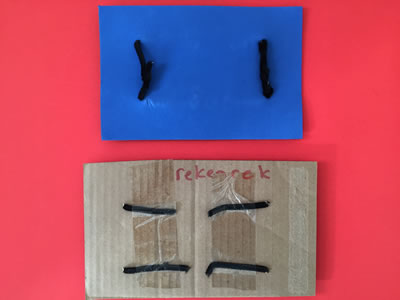
Always move the beads to the right or “start position” to begin. Demonstrate how to move the beads to the left or “action zone.”
“Reset” reminds students to return the beads to the start position.
Counting and Cardinality
Say a number or hold up a numeral card. Children slide beads to show the amount. Touch the beads and count.
Make a set. What is one more? Two more? One less?
Make sets between 10-20.
Addition and Subtraction
3 + 4 = Show me.
If I had 5 stuffed animals and I got 2 more for my birthday, how many would I have? Can you show me?
Hidden Beads
Slide over some beads and cover up with a sheet of paper. How many are hidden? How can you tell?
Doubles
How many doubles can you make on your rekenrek?
Decomposing Numbers
•Show me how to make 7. Can you show me another way? Who can make 7 another way?
Counting Bracelet
A simple version for the beginning of the school year might be a counting bracelet. Simply string 10 beads (5 of two different colors) on a pipe cleaner. Twist the ends to make a bracelet. Slide the beads to make sets, add, subtract, etc.
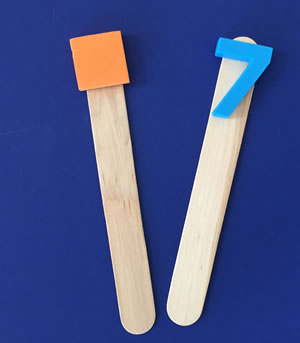
SHAPE AND NUMERAL STICKS
•Glue magnetic numbers and shapes to jumbo craft sticks using a strong craft glue such as E6000.
Numeral Recognition
Pass out numeral sticks to children. Can they walk around the room and match up their numeral with classroom print?
•Let children hold up appropriate sticks as you sing or say rhymes.
Shape Hunt
Pass out shape sticks for children to match in the classroom. Are the shapes flat or solid?
Can You Find?
Children walk around the room and find a number less than theirs. Can they find a number that’s greater? Can they find a number that’s the same?
Number Friends
Call out a number. Students have to find a friend whose stick added to theirs makes the sum. Record the different combinations.
Numerical Order
Can children get in order from 0-9?
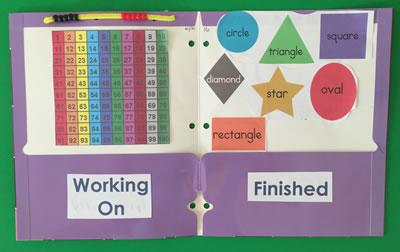
MATH OFFICE
Tape two file folders together for each child. Glue copies of math
concepts you are working on to the folders. For example, a hundreds
chart, days of the week, months of the year, shapes, and so forth. Use a
pipe cleaner and pony beads to make an abacus you can attach at the
top.
SHOW ME CARDS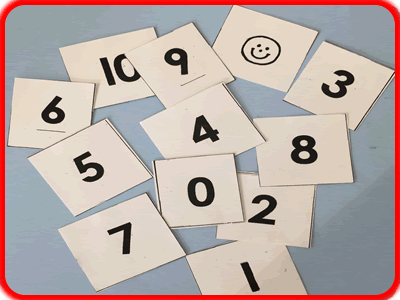
•Make a set of “show me” cards for each child by writing the numerals
0-10 on 3” squares of heavy cardstock. Have children store these cards
in a zip bag in their desk. When you have a few extra minutes, ask the
children to get their cards and arrange them on the floor or table in
numerical order from 0-10. Use the cards for some of the games below.
How Many? Clap, snap, or stomp a set. Show me how many. How many
toes do you have? Show me.
Sets - Make a set with felt pieces on the flannel board. Show me how
many.
Mystery Number - I’m thinking of a number between 4 and 6. Show me. I’m thinking of a number two more than seven. Show me.
Math Facts - 4 plus 2. Show me. 9 minus 3. Show me.
Number Stories - I had four pennies. I found three more. Show me
how many I have in all.
Fact Families - Call out numbers in a fact family. Can children write the equations in that fact family?
Decompose Numbers – How many ways can you make seven?
Expanded Notation - Put 3 in the tens spot and two in the ones spot. What’s the number?
Odd and Even – Sort the odd and even numbers.
Slap Happy Math – Children get a partner and lay a set of numeral cards on the floor between them. The teacher calls out different math problems. The first child to slap the correct numeral gets a point.
Next Page




 an arithmetic (or calculating) rack. It’s a visual way for children to develop a strong sense of 5 and 10. Children can use the rekenrek to count, add, or decompose numbers. Smaller versions of the rekenrek have two rows of ten beads. Five red beads and five white beads. (Versions for older students have more rows.) You can purchase these or make your own from fun foam or cardboard, pipe cleaners, and pony tail beads. String 10 beads (5 of each color) on the pipe cleaner and attach it to the fun foam.
an arithmetic (or calculating) rack. It’s a visual way for children to develop a strong sense of 5 and 10. Children can use the rekenrek to count, add, or decompose numbers. Smaller versions of the rekenrek have two rows of ten beads. Five red beads and five white beads. (Versions for older students have more rows.) You can purchase these or make your own from fun foam or cardboard, pipe cleaners, and pony tail beads. String 10 beads (5 of each color) on the pipe cleaner and attach it to the fun foam.


